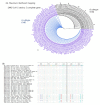A Novel Synonymous Mutation of SARS-CoV-2: Is This Possible to Affect Their Antigenicity and Immunogenicity?
- PMID: 32422894
- PMCID: PMC7349911
- DOI: 10.3390/vaccines8020220
A Novel Synonymous Mutation of SARS-CoV-2: Is This Possible to Affect Their Antigenicity and Immunogenicity?
Abstract
The S glycoprotein of coronaviruses is important for viral entry and pathogenesis with most variable sequences. Therefore, we analyzed the S gene sequences of SARS-CoV-2 to better understand the antigenicity and immunogenicity of this virus in this study. In phylogenetic analysis, two subtypes (SARS-CoV-2a and -b) were confirmed within SARS-CoV-2 strains. These two subtypes were divided by a novel synonymous mutation of D614G. This may play a crucial role in the evolution of SARS-CoV-2 to evade the host immune system. The region containing this mutation point was confirmed as a B-cell epitope located in the S1 domain, and SARS-CoV-2b strains exhibited severe reduced antigenic indexes compared to SARS-CoV-2a in this area. This may allow these two subtypes to have different antigenicity. If the two subtypes have different serological characteristics, a vaccine for both subtypes will be more effective to prevent COVID-19. Thus, further study is urgently required to confirm the antigenicity of these two subtypes.
Keywords: COVID-19; SARS-CoV-2; antigenicity; spike protein.
Conflict of interest statement
The authors declare that they have no competing interests.
Figures



References
Grants and funding
LinkOut - more resources
Full Text Sources
Other Literature Sources
Miscellaneous

